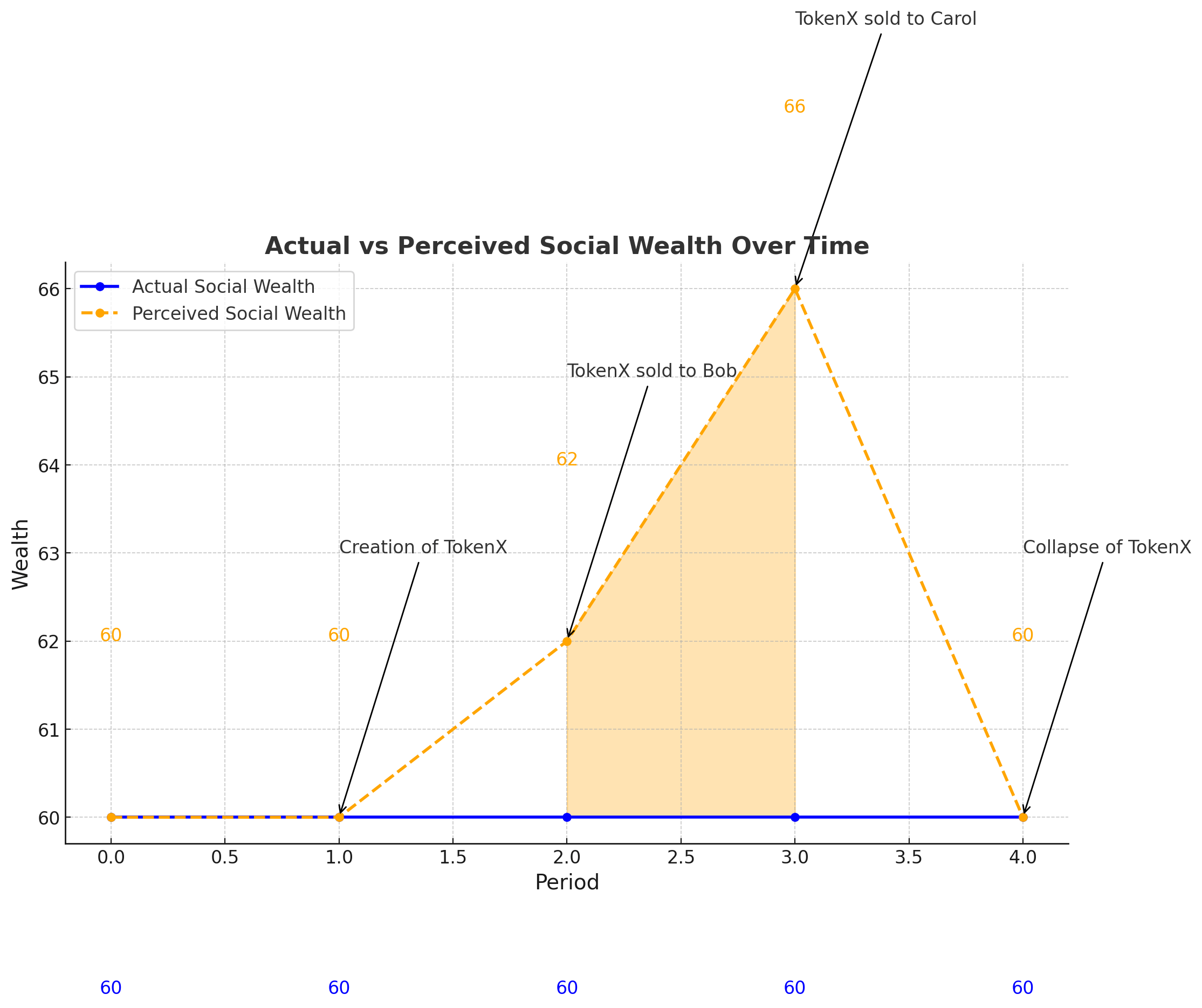
Wealth Perception in Inflated Bubble Assets
3 June, 2024
Cryptocurrencies have taken the financial world by storm, with Americans alone holding over $1 trillion in various digital currencies. This surge has led many to question whether this represents real wealth creation. From an economic theory perspective, the answer is complex. Wealth in society is traditionally seen as real assets that produce consumable goods and services. Cryptocurrencies, unless providing some form of convenience yield, challenge this notion of wealth creation. In this article I explore this paradox, using a simple numerical example to explain the concept of "Inflated Bubble Assets."
Understanding Inflated Assets
The Concept
Inflated bubble assets refers to the perceived increase in wealth that arises from trading assets with no intrinsic value. This concept is illustrated through a hypothetical example involving three individuals: Alice, Bob, and Carol, each holding 20 units of stock representing future consumption. The key idea is that speculative trading can inflate perceived wealth without creating real value.
Numerical Example
Initial State
In period 0, the economy consists of three individuals, each with 20 units of stock:
| Period | Alice's Holdings | Bob's Holdings | Carol's Holdings | Social Wealth | Perceived Social Wealth |
|---|---|---|---|---|---|
| 0 | 20 | 20 | 20 | 60 | 60 |
Creation of Digital Token
In period 1, Alice creates a digital token called TokenX, which offers no future consumption rights or interest but is designed to trade freely. Initially, there is no change in perceived wealth:
| Period | Alice's Holdings | Bob's Holdings | Carol's Holdings | Social Wealth | Perceived Social Wealth |
|---|---|---|---|---|---|
| 1 | 20 + TokenX | 20 | 20 | 60 | 60 |
Trading TokenX
In period 2, Alice sells TokenX to Bob for two units of stock. The perceived wealth increases as Bob believes TokenX is worth at least two units:
| Period | Alice's Holdings | Bob's Holdings | Carol's Holdings | Social Wealth | Perceived Social Wealth |
|---|---|---|---|---|---|
| 2 | 22 | 18 + TokenX | 20 | 60 | 62 |
In period 3, Carol buys TokenX from Bob for four units, anticipating a future price rise. The perceived wealth further increases:
| Period | Alice's Holdings | Bob's Holdings | Carol's Holdings | Social Wealth | Perceived Social Wealth |
|---|---|---|---|---|---|
| 3 | 22 | 22 | 16 + TokenX | 60 | 66 |
Collapse of TokenX
In period 4, investors realize TokenX has no intrinsic value, and its price collapses. The perceived social wealth drops back to the actual social wealth:
| Period | Alice's Holdings | Bob's Holdings | Carol's Holdings | Social Wealth | Perceived Social Wealth |
|---|---|---|---|---|---|
| 4 | 22 | 22 | 16 | 60 | 60 |
Implications
This example shows that the creation and trading of TokenX did not create real wealth but merely transferred it among individuals. The rise in perceived wealth due to speculative trading is what we term bubble wealth. The collapse of TokenX's value simply redistributes wealth, leaving the society's actual wealth unchanged.
Real-World Applications
Cryptocurrencies and Stocks
While the example of TokenX might seem purely theoretical, it closely mirrors real-world scenarios involving cryptocurrencies like Bitcoin and certain stocks. These assets often trade at values disconnected from their fundamental worth due to speculative demand. For instance, the meteoric rise and subsequent fall of Bitcoin prices over the past decade can be attributed to speculative trading and investor hype rather than intrinsic value.
Catalysts for Trading
In reality, various factors can catalyze trading in assets like TokenX. These include the desire for anonymity in transactions, avoiding taxes, or serving as a speculative investment. As prices rise, the momentum can become self-fulfilling, driven by incomplete information and diverse investor beliefs, as described by Harrison and Kreps (1978). Cryptocurrencies can also serve as a hedge against inflation or as a store of value in countries with unstable economies.
Economic and Social Impact
Market Frictions and Wealth Destruction
The crash of speculative assets can lead to significant wealth destruction, particularly when market frictions and political factors are involved. Individuals' spending decisions, based on perceived wealth, can have broader macroeconomic effects. For example, during the cryptocurrency market crash in 2018, many investors faced substantial losses, leading to reduced consumer spending and investment in other areas.

Speculative Cycles
The initial rise and eventual collapse of speculative assets require specific catalysts. For the rise, speculative demand and optimism drive prices up. For the crash, the realization that the asset provides no real consumption value leads to a sell-off, causing the price to plummet. This cycle was evident during the dot-com bubble in the late 1990s and early 2000s, where the perceived value of internet companies far exceeded their actual value.
Conclusion
Cryptocurrencies and similar speculative assets present a unique challenge to traditional notions of wealth creation. While they can generate perceived wealth through trading, this wealth is often transient and susceptible to dramatic collapses. In this article I highlight the need for market participants to be vigilant when holding large proportion of their wealth in cryptocurrency. Often, the crypto liquidation value may be substantially below the prevailing market value. Understanding the dynamics of bubble wealth and its implications is crucial for investors and policymakers navigating the evolving financial landscape.